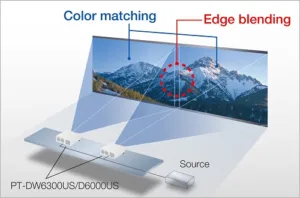VESA has updated its Multiple Projection Common Data Interchange (MPCDI) standard, with changes intended to mitigate the colour differences that arise when blending the output of different projectors. Version 2.0 of the standard should enable greater performance in terms of colour consistency, brightness and intensity, says VESA.
MPCDI was introduced in mid-2013 to standardise techniques such as warping and edge-blending. V2.0 builds on this, enabling the output of projectors from different manufacturers to be blended together, regardless of technology. Full 3D lookup tables are also supported.
Image credit: PanasonicThe new additions include:
- Colour definitions – Formatting and storage of lookup tables are defined, along with input-colour-to-blending-to-output-colour mapping equations and associated use cases.
- Colour XML specifications – To store the definitions, the XML header was modified to allow pointing to the appropriate files and storage of the non-file correction parameters.
- Revised extension example – The original extension example (a colour lookup table storing a series of .png files) is now covered in the standard directly. The new example provided is a lookup table for distortion and correction for chromatic aberration, with a separate RGB warp.
Combined with MPCDI v1.0, these new parameters enable the free interchange of data structures. These provide a video definition for both content and intensity of colours that have been altered for edge-blending, etc. The definition also includes geometric data, intensity, colour and topographic information about each of the linked displays.

